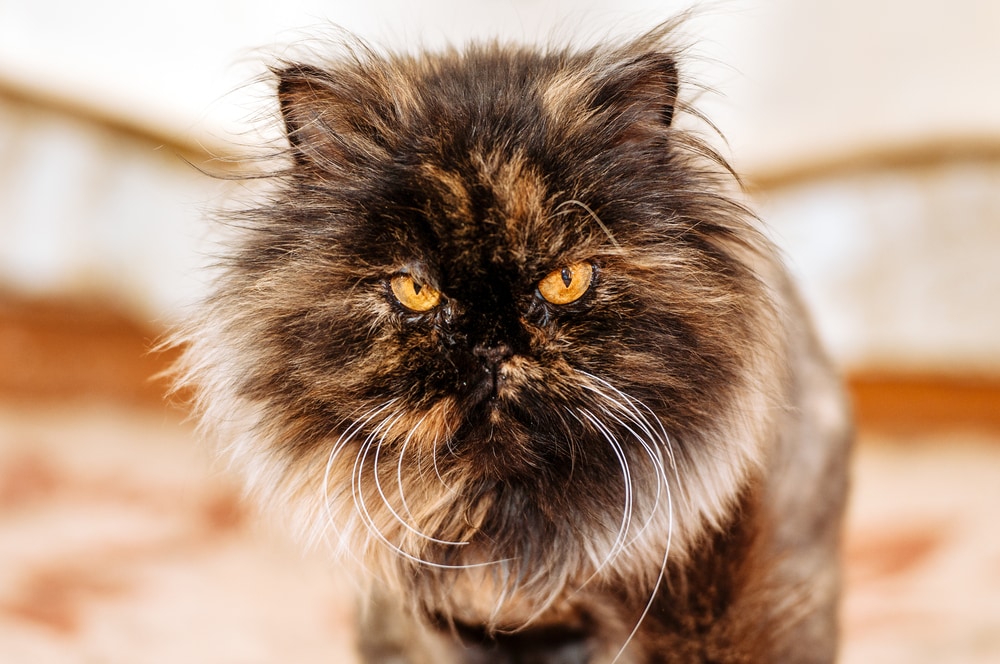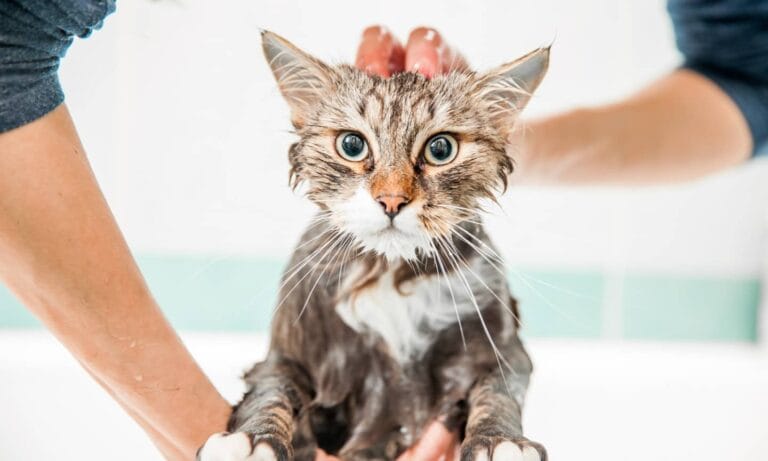See how you can keep your Persian cat’s fur from getting “tear stains” and what the perfect Persian cat face looks like to cat show judges.
Eye Care
Because of their short noses and muzzles, Persians have more problems with eye debris than other breeds. The comparatively large eye openings placed too close to the nasal tear ducts create an area that is prone to tearing. In most breeds, the tears gather in the ducts; in Persians, they may spill over the lower eyelids. Also, when the tears come in contact with the air, they are oxidized and turn brown, staining the under-eye with a tough, gluey substance. To keep your cat comfortable, you need to keep this area clean. Wipe your Persian’s eyes with a damp, clean cloth (no soap) once or twice a day. Don’t rub the eyeball directly, of course.
If you think your Persian has excessive or unusual tear-staining, consult your vet. If there’s no medical problem, you can try one of many commercial tear-stain removal products. Offering your cat distilled water, in place of tap water, to drink may also alleviate the tear-stain problem.
Don’t Forget The Ears
Inspect your cat’s ears every week. Unattended ears can turn into homes for ear mites, bacterial infections, yeast infections, allergies and even fungal infections around the tips of the ears. Regular cleaning will do much to prevent such infections and infestations. Gently examine the inside of the ear. Redness can indicate an allergy or inflammation, black debris suggests ear mites, and green or yellow discharge is characteristic of an infection. Other warning signs include head shaking. A slight amount of waxy buildup is normal.
Many cats resist having their ears cleaned, so you may want to use a towel for restraint. “Think of your cat like a, well, a burrito,” says Kathy Kaminski, a Persian breeder from Waynesboro, Pennsylvania. “Put a big thick towel on a table, put the cat on the towel, and warp it up, with the tail and head left exposed,” Kaminski says. “Then, bring the back end of the towel over to the front, just behind the cat’s head. Now the tail is covered. Finish by tucking the loose ends underneath. Your cat is now ready, not to cook, but to have its ears cleaned.” This method will let you hold the cat with one hand, so you can clean the ears with the other.
Of course, if you have a good-natured cat, restraint may not be necessary. “Cats really dislike restraint, so use as little as you need to get the job done,” Kaminski says. It also helps to use small cat treats to keep the experience as positive as possible. Don’t combine ear cleaning with other possibly unpleasant experiences such as bathing or nail clipping.
Clean the ears with a gentle ear cleanser or a medicated wipe (available through your vet or at pet-supply stores). If you’re using a liquid cleanser, partially fill the ear canal with the product. Pull the ear straight out (gently) with the flap of the ear between your thumb and forefinger to allow the liquid to flow deep into the ear. Then massage the base of the ear for 15 or 20 seconds; your cat will probably enjoy this part! Allow your cat to shake its head; this will remove much of the debris present in the ear. If you’ve been well instructed by a vet or professional groomer on how to safely use a cotton swab to wipe out the debris, you may do so, but don’t probe so deeply that the cotton tip disappears from view. It’s safer to use a gauze wipe or cotton ball and your finger. A cotton swab can damage the delicate tissue or even break an eardrum, especially if an infection is present. If your cat is on medication for ear mites or has an infection, apply the drops in after the ears are cleaned.
Nail Trimming
Typically, a cat has five claws on each front paw and four in the back.
Trim the nails every 10 to 14 days, and begin early, while your cat is still a kitten. Surprising an adult cat with its first nail trim is likely to yield undesirable results.
A good time to trim the nails is right before you bathe your cat — not for the cat’s sake, but for your own. Even the best-behaved Persian with the finest cat shampoo can get a bit grumpy at bath-time!
You can purchase special cat nail clippers at pet-supply stores. Start by holding one paw in your hand, with the forefinger below the toe nail you wish to clip. Place your thumb over the top of this same toe and squeeze gently — the entire nail will appear. Clip the nail just in front of the pink area. This area is hard to see in cats with dark nails (luckily a distinct minority). If you can’t see the quick (the vein inside the nail), clip just below the point at which the nail begins to curve downward. If you feel uncomfortable, ask your veterinarian’s technician to show you how.
Be careful not to cut into the quick — it will bleed and it hurts your cat. Always keep some styptic powder on hand in case you make a mistake. Some brands have benzocaine in them, which will stop or greatly reduce the pain associated with quicked nails.
Face Sculpting
Show groomers and people with show cats may attempt “face sculpting,” a cut that’s designed to show off your Persian’s trademark expression. You can begin face sculpting when your kitten is about 5 months old. For equipment, buy a pair of small, blunt, curved, high-quality scissors and a pair of thinning shears. You may also need a stripping knife to even out a mix of long and short hairs. To use a stripping knife, hold it with your thumb on the top, rounded portion of the blade. “By holding the knife at different angles, you can remove just a few hairs or a whole section — it’s best to practice on a non-show cat until you get the hang of it,” DiFatta says. You can find these supplies at your local pet- and grooming-supply store and online.
Begin after your cat is brushed and bathed. Put the cat on a contrasting surface — you will need an eagle eye.
Think round. “The round face is ideal,” DiFatta says. “The perfect show cat is art. The best way to get an eye for this is to take lots of snapshots of your cat’s head from various angles. Once the basic cut is made to your liking, it’s easy to maintain, and you’ll only need to pluck stray hairs away occasionally.”
Start rounding the ear with the curved scissors. Ears should not stand out in this breed, but the fine round cheeks should be emphasized. Trim the hair away above the eyes if it is so long that if brushed down would cover the eyes. Use the thinning shears to trim away the “horns” that sometimes grow on the side of the eyes and spoil the outline. Don’t cut off the whiskers, but you can hand-pluck any excess hairs — just a few at a time, please! Remember — you can’t put it back.
Whether your grooming is simple and functional, or designed to take first prize at the local cat show, your Persian’s supreme elegance will shine through and through.
Lion Cuts
If the knots in your Persian’s fur are truly awful, you may want to consider a lion cut, in which part of the body is shaved, sort of like a Poodle. As in the Poodle, the tail, legs and “mane” are left long. Not surprisingly, cats are not allowed to be shown in this cut, but it’s still quite striking. (However, your cat may need a sweater to keep warm in the winter.) If you don’t like that look, you might opt for having your cat shaved down completely until a new coat can grow out. Don’t try to do this yourself — ask your vet or a professional groomer.
Super Groomer
If you decide to take your cat to a groomer, choose one who’s familiar with cats. Many groomers specialize in dogs and some lack the extra gentle skills needed for cat grooming. This is especially true if you have a cat with a matted coat. These coats can often be saved, but it requires a patient expert. Talk to your vet or breeder about someone in your area who is capable of this delicate task. Groomers are particularly adept at handling aggressive cats. Often, a cat that will act out with its owner becomes more docile in the hands of a trained professional.
Posted By: Chewy Editorial
Featured Image: Via Mitskevich Uladzimir/Shutterstock
Share:









